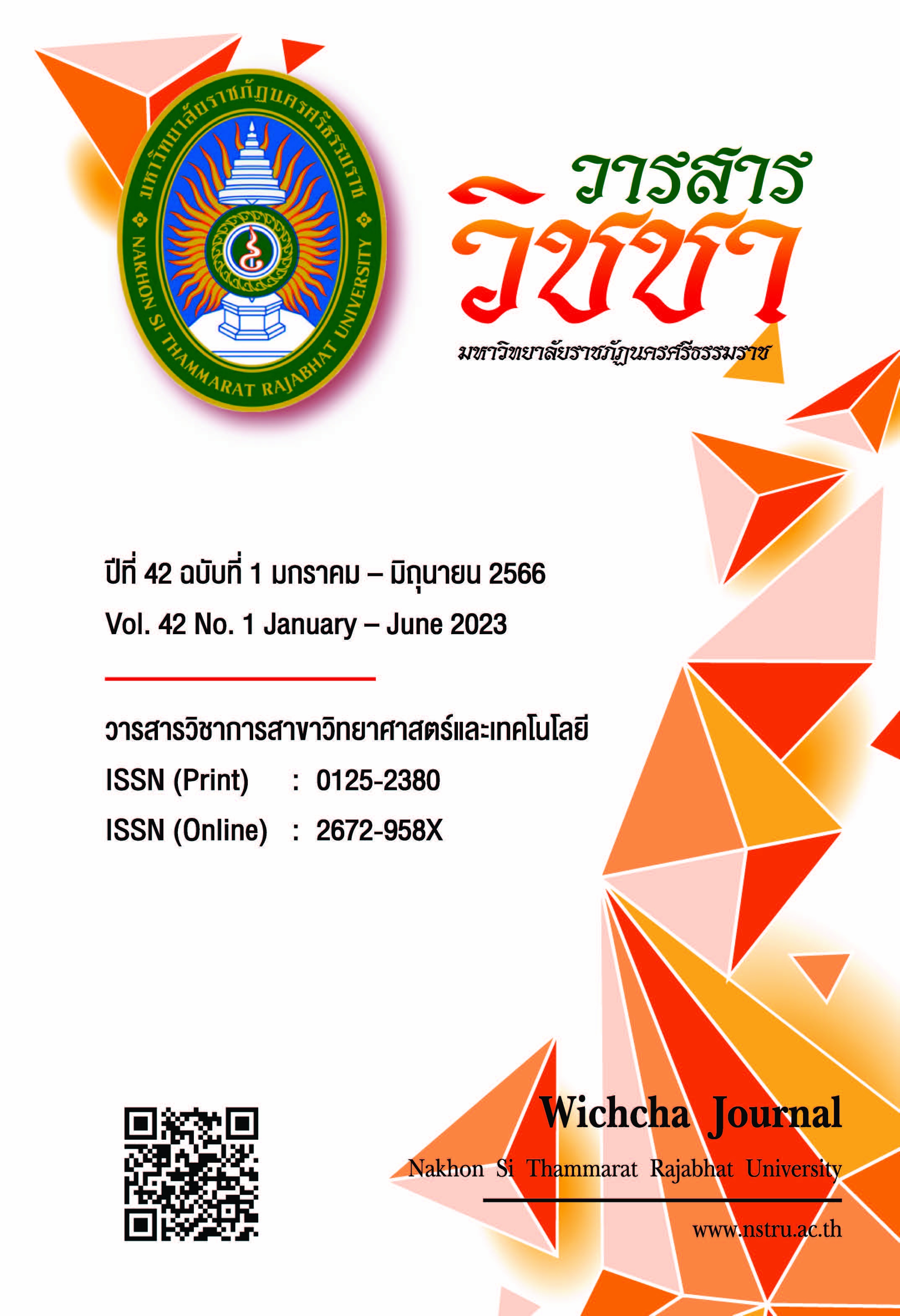ประสิทธิภาพในการต้านอนุมูลอิสระของผักพื้นบ้านในจังหวัดสุราษฎร์ธานี
Main Article Content
บทคัดย่อ
การวิจัยนี้เป็นการวิจัยเชิงทดลองมีวัตถุประสงค์เพื่อศึกษาประสิทธิภาพการต้านอนุมูลอิสระของผักพื้นบ้านและเปรียบเทียบความแตกต่างของประสิทธิภาพในการต้านอนุมูลอิสระของผักพื้นบ้าน 10 ชนิด ได้แก่ กระถิน ขี้เหล็ก ชะคราม ตะลิงปลิง เนียง ใบมะกอก ยอดสะเดา สะตอ เสม็ดแดง และเหลียง ทั้งในฤดูฝนและฤดูร้อนในจังหวัดสุราษฎร์ธานี โดยวิธี 2,2-Diphenyl-1-picrylhydrazyl (DPPH) วิเคราะห์ข้อมูลทางสถิติด้วยค่าร้อยละ ค่าเฉลี่ย ส่วนเบี่ยงเบนมาตรฐาน ค่าควอร์ไทล์ ความแปรปรวนทางเดียว และการทดสอบค่าที ผลการวิจัยพบว่าผักพื้นบ้านในฤดูฝนมีประสิทธิภาพในการต้านอนุมูลอิสระอยู่ในช่วงระหว่างร้อยละ 2.87-92.03 โดยผักพื้นบ้านที่มีประสิทธิภาพในการต้านอนุมูลอิสระในระดับสูง ได้แก่ ขี้เหล็ก (ร้อยละ 92.03±18.01) รองลงมา คือ ยอดสะเดา (ร้อยละ 78.83±13.64) และสะตอ (ร้อยละ 73.73±18.08) ตามลำดับ สำหรับประสิทธิภาพในการต้านอนุมูลอิสระของผักพื้นบ้านในฤดูร้อนอยู่ในช่วงระหว่างร้อยละ 2.70-79.16 โดยผักพื้นบ้านที่มีประสิทธิภาพในการต้านอนุมูลอิสระระดับสูง ได้แก่ กระถิน (ร้อยละ 79.16±14.38) ขี้เหล็ก (ร้อยละ 71.16±7.75) และสะตอ (ร้อยละ 64.06±5.81) ตามลำดับ เมื่อเปรียบเทียบความแตกต่างระหว่างประสิทธิภาพในการต้านอนุมูลอิสระของผักพื้นบ้านในฤดูฝนและฤดูร้อน พบว่าประสิทธิภาพในการต้านอนุมูลอิสระของผักพื้นบ้านทั้ง 2 ฤดูมีความแตกต่างกันอย่างมีนัยสำคัญทางสถิติที่ระดับ 0.05 จากผลการศึกษานี้แสดงให้เห็นว่าผักพื้นบ้านเป็นแหล่งที่ดีของสารต้านอนุมูลอิสระ จึงเป็นทางเลือกหนึ่งในการบริโภคผักพื้นบ้านเพื่อสุขภาพ
Article Details

This work is licensed under a Creative Commons Attribution-NonCommercial-NoDerivatives 4.0 International License.
เนื้อหาและข้อมูลในบทความที่ลงตีพิมพ์ในวารสารวิชชา มหาวิทยาลัยราชภัฏนครศรีธรรมราช ถือเป็นข้อคิดเห็นและความรับผิดชอบของผู้เขียนบทความโดยตรง ซึ่งกองบรรณาธิการวารสารไม่จำเป็นต้องเห็นด้วยหรือร่วมรับผิดชอบใด ๆ
บทความ ข้อมูล เนื้อหา รูปภาพ ฯลฯ ที่ได้รับการตีพิมพ์ในวารสารวิชชา มหาวิทยาลัยราชภัฏนครศรีธรรมราช ถือเป็นลิขสิทธ์ของวารสารวิชชา มหาวิทยาลัยราชภัฏนครศรีธรรมราช หากบุคคลหรือหน่วยงานใดต้องการนำข้อมูลทั้งหมดหรือส่วนหนึ่งส่วนใดไปเผยแพร่ต่อหรือเพื่อการกระทำการใด ๆ จะต้องได้รับอนุญาตเป็นลายลักษณ์อักษรจากวารสารวิชชา มหาวิทยาลัยราชภัฏนครศรีธรรมราชก่อนเท่านั้น
The content and information in the article published in Wichcha journal Nakhon Si Thammarat Rajabhat University, It is the opinion and responsibility of the author of the article. The editorial journals do not need to agree. Or share any responsibility.
References
ชัชฎาพร องอาจ. (2558). คุณสมบัติการต้านอนุมูลอิสระของผักพื้นบ้านในจังหวัดพระนครศรีอยุธยา. วารสารวิทยาศาสตร์เกษตร, 46(3), 321-324.
ดลฤดี พิชัยรัตน์ และนพรัตน์ มะเห. (2557). ผลของการลวกต่อปริมาณสารประกอบฟีนอลิกและสมบัติการต้านปฏิกิริยาออกซิเดชันของผักพื้นบ้านภาคใต้บางชนิด. วารสารวิจัย มหาวิทยาลัยเทคโนโลยีราชมงคลศรีวิชัย, 6(2), 36-46.
บุหรัน พันธุ์สวรรค์. (2556). อนุมูลอิสระ สารต้านอนุมูลอิสระ และการวิเคราะห์ฤทธิ์ต้านอนุมูลอิสระ. วารสารวิทยาศาสตร์และเทคโนโลยี, 21(3), 275-286.
ประกิต ไชยธาดา อัญญารัตน์ ล้ำเลิศ ชารีน่า เกตุมณี และธวัชชัย คงนุ่ม. (2562). ความสัมพันธ์ของปริมาณฟีนอลิกรวมและปริมาณฟลาโวนอยด์รวมที่มีต่อฤทธิ์ต้านอนุมูลอิสระของแหมะและหมากหมก. วารสารวิชชา มหาวิทยาลัยราชภัฏนครศรีธรรมราช, 38(2), 120-134.
พนิดา แสนประกอบ. (2561). การศึกษาสารประกอบฟีนอลิกรวมและฤทธิ์ต้านอนุมูลอิสระของผักพื้นบ้านในจังหวัดร้อยเอ็ด. วารสารวิชาการเกษตร, 36(3), 293-301.
สุนันทา ข้องสาย และลักษมี วิทยา. (2562). สารประกอบฟีนอลิก สารประกอบฟลาโวนอยด์ และฤทธิ์ต้านอนุมูลอิสระของสารสกัดจากเสม็ดขาวและเสม็ดแดง. รายงานวิจัย. มหาวิทยาลัยเทคโนโลยีราชมงคลศรีวิชัย.
อรรถเกียรติ กาญจนพิบูลวงศ์ ภาณุวัฒน์ คำวังสง่า และสุธิดา แก้วทา. (2562). รายงานสถานการณ์โรค NCDs เบาหวาน ความดันโลหิตสูง และปัจจัยเสี่ยงที่เกี่ยวข้อง พ.ศ. 2562. กรุงเทพฯ: อักษรกราฟฟิคแอนด์ดีไซน์.
โอภา วัชระคุปต์ ปรีชา บุญจูง จันทนา บุญยะรัตน์ และมาลีรักษ์ อัตต์สินทอง. (2550). สารต้านอนุมูลอิสระ (radical scavenging agents). (พิมพ์ครั้งที่ 2). กรุงเทพฯ: นิวไทยมิตรการพิมพ์.
Aires, A., Fernandes, C., Carvalho, R., Bennett, R.N., Saavedra, M.J. and Rosa, E.A. (2011) Seasonal effects on bioactive compounds and antioxidant capacity of six economically important Brassica vegetables. Molecules, 16(8), 6816-6832, doi: https://doi.org/10.3390/molecules16086816.
Aksoy, L., Kolay, E., Agılonua, Y., Aslan, Z. and Kargıoglu, M. (2013). Free radical scavenging activity, total phenolic content, total antioxidant status, and total oxidant status of endemic Thermopsis turcica. Saudi Journal of Biological Sciences, 20(3), 235-239, doi: https://doi.org/10.1016/j.sjbs.2013.02.003.
Aldrich, H.T., Kendall, P., Bunning, M., Stonaker, F., Kulen, O. and Stushnoff, C. (2011). Environmental temperatures influence antioxidant properties and mineral content in broccoli cultivars grown organically and conventionally. Journal of Agronomy and Crop Science, 2, 1-10.
Anwar, F., Kalsoom, U., Sultana, B., Mushtaq, M., Mehmood, T. and Arshad, H.A. (2013). Effect of drying method and extraction solvent on the total phenolics and antioxidant activity of cauliflower (Brassica Oleracea L.) extracts. International Food Research Journal, 20(2), 653-659.
Arias, A., Feijoo, G. and Moreira, M.T. (2022). Exploring the potential of antioxidants from fruits and vegetables and strategies for their recovery. Innovative Food Science and Emerging Technologies, 77(10), 1-16, doi: https://doi.org/10.1016/j.ifset.2022.102974.
Aune, D. (2019). Plant foods, antioxidant biomarkers, and the risk of cardiovascular disease, cancer, and mortality: A review of the evidence. Advances in Nutrition, 10(4), S404-S421, doi: https://doi.org/10.1093/advances/nmz042.
Bhandari, S.R. and Kwak, J.H. (2014). Seasonal variation in phytochemicals and antioxidant activities in different tissues of various Broccoli cultivars. African Journal of Biotechnology, 13(4), 604-615, doi: https://doi.org/10.5897/AJB2013.13432.
Fidrianny, I., Utari, P. and Ruslan, W.K. (2014). Evaluation of antioxidant capacities, flavonoid, phenolic, carotenoid content from various extracts of four kinds Brassica herbs. International Journal of Pharmacy and Pharmaceutical Sciences, 6(2), 265-272.
Jideani, A., Silungwe, H., Takalani, T., Omolola, A.O., Udeh, H.O. and Anyasi, T.A. (2021). Antioxidant-rich natural fruit and vegetable products and human health. International Journal of Food Properties, 24(1), 41-67, doi: https://doi.org/10.1080/10942912.2020.1866597.
Kahkonen, M.P., Hopia, A.I., Vuorela, H.J., Rauha, J.P., Pihlaja, K., Kujala, T.S. and Heinonen, M. (1999). Antioxidant activity of plant extracts containing phenolic compounds. Journal of Agricultural and Food Chemistry, 47(10), 3954-3962, doi: https://doi.org/10.1021/jf990146l.
Kasangana, P.B., Haddad, P.S. and Stevanovic, T. (2015). Study of polyphenol content and antioxidant capacity of Myrianthus arboreus (Cecropiaceae) root bark extracts. Antioxidants, 4(2), 410-426, doi: https://doi.org/10.3390/antiox4020410.
Kongkachuichai, R., Charoensiri, R., Yakoh, K., Kringkasemsee, A. and Insung, P. (2015). Nutrients value and antioxidant content of indigenous vegetables from Southern Thailand. Food Chemistry, 173, 838-846, doi: https://doi.org/10.1016/j.foodchem.2014.10.123.
Ou, B., Huang, D., Hampsch-Woodill, M., Flanagan, J.A. and Deemer, E.K. (2002). Analysis of antioxidant activities of common vegetables employing oxygen radical absorbance capacity (ORAC) and ferric reducing antioxidant power (FRAP) assays: A comparative study. Journal of Agricultural and Food Chemistry, 50(11), 3122-3128, doi: https://doi.org/10.1021/jf0116606.
Porter, Y. (2012). Antioxidant properties of green broccoli and purple-sprouting broccoli under different cooking conditions. BioscienceHorizons, 5, 1-11, doi: https://doi.org/10.1093/biohorizons/hzs004.
Prior, R.L., Wu, X., and Schaich, K. (2005). Standardized methods for the determination of antioxidant capacity and phenolics in foods and dietary supplements. Journal of Agricultural and Food Chemistry, 53(10), 4290-4302, doi: https://doi.org/10.1021/jf0502698.
Samec, D., Piljac-Zegarac, J., Bogovic, M., Habjanic, K. and Gruz, J. (2011). Antioxidant potency of white (Brassica oleracea L. var. capitata) and Chinese (Brassica rapa L. var. pekinensis (Lour.)) cabbage: The influence of development stage, cultivar choice and seed selection. Scientia Horticulturae, 128(2), 78-83, doi: https://doi.org/10.1016/j.scienta.2011.01.009.
Sharma, O.P. and Bhat, T.K. (2009). DPPH antioxidant assay revisited. Food Chemistry, 113(4), 1202-1205, doi: https://doi.org/10.1016/j.foodchem.2008.08.008.
Sivaci, A. and Duman, S. (2014). Evaluation of seasonal antioxidant activity and total phenolic compounds in stem and leaves of some almond (Prunus amygdalus) varieties. Biological Research, 47(9), 1-5, doi: https://doi.org/10.1186/0717-6287-47-9.
Somsub, W., Kongkachuichai, R., Sungpuag, P. and Charoensiri, R. (2008). Effects of three conventional cooking methods on vitamin c, tannin, myo-inositol phosphates contents in selected Thai vegetables. Journal of Food Composition and Analysis, 21(2), 187-197, doi: https://doi.org/10.1016/j.jfca.2007.08.002.
Thaipong, K., Boonprakob, U., Crosbyb, K., Cisneros-Zevallosc, L., and Byrne, D.H. (2006). Comparison of ABTS, DPPH, FRAP, and ORAC assays for estimating antioxidant activity from guava fruit extracts. Journal of Food Composition and Analysis, 19(1), 669-675, doi: https://doi.org/10.1016/j.jfca.2006.01.003.
Tharasena, B. and Lawan, S. (2014). Phenolics, flavonoids and antioxidant activity of vegetables as Thai side dish. APCBEE Procedia, 8, 99-104, doi: https://doi.org/10.1016/j.apcbee.2014.03.008.
Venkatachalam, K., Rangasamy, R. and Krishnan, V. (2014). Total antioxidant activity and radical scavenging capacity of selected fruits and vegetables from South India. International Food Research Journal, 21(3), 1039-1043.
Wan, H., Liu, R., Sun, H., Yu, X., Li, Y., Cong, T. and Liu, D. (2014). Caco-2 cell-based antioxidant activity of 36 vegetables commonly consumed in China. Journal of Food and Nutrition Research, 2(2), 88-95, doi: https://doi.org/10.12691/jfnr-2-2-5.
World Health Organization. (2022). Health topics. Retrieved 1 September 2022, from: https://www.who.int/news-room/fact-sheets/detail/noncommunicable-diseases.

